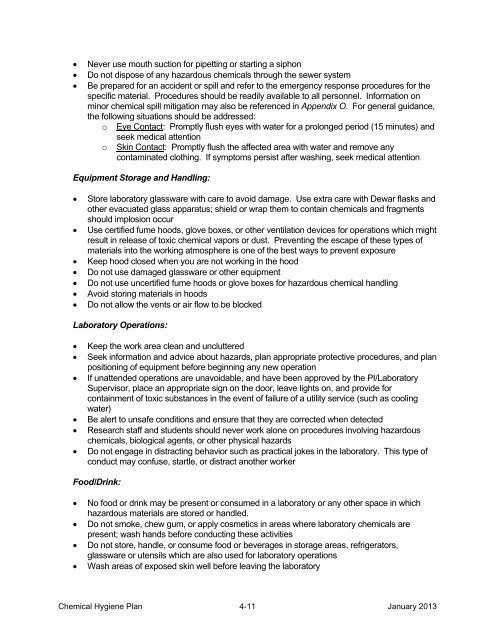Lab Safety Manual - UCLA - Environment, Health & Safety
Lab Safety Manual - UCLA - Environment, Health & Safety
Lab Safety Manual - UCLA - Environment, Health & Safety
Create successful ePaper yourself
Turn your PDF publications into a flip-book with our unique Google optimized e-Paper software.
Never use mouth suction for pipetting or starting a siphon<br />
Do not dispose of any hazardous chemicals through the sewer system<br />
Be prepared for an accident or spill and refer to the emergency response procedures for the<br />
specific material. Procedures should be readily available to all personnel. Information on<br />
minor chemical spill mitigation may also be referenced in Appendix O. For general guidance,<br />
the following situations should be addressed:<br />
o Eye Contact: Promptly flush eyes with water for a prolonged period (15 minutes) and<br />
seek medical attention<br />
o Skin Contact: Promptly flush the affected area with water and remove any<br />
contaminated clothing. If symptoms persist after washing, seek medical attention<br />
Equipment Storage and Handling:<br />
Store laboratory glassware with care to avoid damage. Use extra care with Dewar flasks and<br />
other evacuated glass apparatus; shield or wrap them to contain chemicals and fragments<br />
should implosion occur<br />
Use certified fume hoods, glove boxes, or other ventilation devices for operations which might<br />
result in release of toxic chemical vapors or dust. Preventing the escape of these types of<br />
materials into the working atmosphere is one of the best ways to prevent exposure<br />
Keep hood closed when you are not working in the hood<br />
Do not use damaged glassware or other equipment<br />
Do not use uncertified fume hoods or glove boxes for hazardous chemical handling<br />
Avoid storing materials in hoods<br />
Do not allow the vents or air flow to be blocked<br />
<strong>Lab</strong>oratory Operations:<br />
Keep the work area clean and uncluttered<br />
Seek information and advice about hazards, plan appropriate protective procedures, and plan<br />
positioning of equipment before beginning any new operation<br />
If unattended operations are unavoidable, and have been approved by the PI/<strong>Lab</strong>oratory<br />
Supervisor, place an appropriate sign on the door, leave lights on, and provide for<br />
containment of toxic substances in the event of failure of a utility service (such as cooling<br />
water)<br />
Be alert to unsafe conditions and ensure that they are corrected when detected<br />
Research staff and students should never work alone on procedures involving hazardous<br />
chemicals, biological agents, or other physical hazards<br />
Do not engage in distracting behavior such as practical jokes in the laboratory. This type of<br />
conduct may confuse, startle, or distract another worker<br />
Food/Drink:<br />
No food or drink may be present or consumed in a laboratory or any other space in which<br />
hazardous materials are stored or handled.<br />
Do not smoke, chew gum, or apply cosmetics in areas where laboratory chemicals are<br />
present; wash hands before conducting these activities<br />
Do not store, handle, or consume food or beverages in storage areas, refrigerators,<br />
glassware or utensils which are also used for laboratory operations<br />
Wash areas of exposed skin well before leaving the laboratory<br />
Chemical Hygiene Plan 4-11 January 2013
















